» Site Map
» Home Page
Historical Info
» Find Friends - Search Old Service and Genealogy Records
» History
» QAIMNS for India
» QAIMNS First World War
» Territorial Force Nursing Service TFNS
» WW1 Soldiers Medical Records
» Field Ambulance No.4
» The Battle of Arras 1917
» The German Advance
» Warlencourt Casualty Clearing Station World War One
» NO 32 CCS Brandhoek - The Battle of Passchendaele
» Chain of Evacuation of Wounded Soldiers
» Allied Advance - Hundred Days Offensive
» Life After War
» Auxiliary Hospitals
» War Graves Nurses
» Book of Remembrance
» Example of Mentioned in Despatches Letter
» Love Stories
» Autograph Book World War One
» World War 1 Letters
» Service Scrapbooks
» QA World War Two
» Africa Second World War
» War Diaries of Sisters
» D Day Normandy Landings
» Belsen Concentration Camp
» Italian Sailor POW Camps India World War Two
» VE Day
» Voluntary Aid Detachment
» National Service
» Korean War
» Gulf War
» Op Telic
» Op Gritrock
» Royal Red Cross Decoration
» Colonels In Chief
» Chief Nursing Officer Army
» Director Army Nursing Services (DANS)
» Colonel Commandant
» Matrons In Chief (QAIMNS)
Follow us on Twitter:

» Grey and Scarlet Corps March
» Order of Precedence
» Motto
» QA Memorial National Arboretum
» NMA Heroes Square Paving Stone
» NMA Nursing Memorial
» Memorial Window
» Stained Glass Window
» Army Medical Services Monument
» Recruitment Posters
» QA Association
» Standard
» QA and AMS Prayer and Hymn
» Books
» Museums
Former Army Hospitals
UK
» Army Chest Unit
» Cowglen Glasgow
» CMH Aldershot
» Colchester
» Craiglockhart
» DKMH Catterick
» Duke of Connaught Unit Northern Ireland
» Endell Street
» First Eastern General Hospital Trinity College Cambridge
» Ghosts
» Hospital Ghosts
» Haslar
» King George Military Hospital Stamford Street London
» QA Centre
» QAMH Millbank
» QEMH Woolwich
» Medical Reception Station Brunei and MRS Kuching Borneo Malaysia
» Military Maternity Hospital Woolwich
» Musgrave Park Belfast
» Netley
» Royal Chelsea Hospital
» Royal Herbert
» Royal Brighton Pavilion Indian Hospital
» School of Physiotherapy
» Station Hospital Ranikhet
» Station Hospital Suez
» Tidworth
» Ghost Hunt at Tidworth Garrison Barracks
» Wheatley
France
» Ambulance Trains
» Hospital Barges
» Ambulance Flotilla
» Hospital Ships
Germany
» Berlin
» Hamburg
» Hannover
» Hostert
» Iserlohn
» Munster
» Rinteln
» Wuppertal
Cyprus
» TPMH RAF Akrotiri
» Dhekelia
» Nicosia
Egypt
» Alexandria
China
» Shanghai
Hong Kong
» Bowen Road
» Mount Kellett
» Wylie Road Kings Park
Malaya
» Kamunting
» Kinrara
» Kluang
» Penang
» Singapore
» Tanglin
» Terendak
Overseas Old British Military Hospitals
» Belize
» Falklands
» Gibraltar
» Kaduna
» Klagenfurt
» BMH Malta
» Nairobi
» Nepal
Middle East
» Benghazi
» Tripoli
Field Hospitals
» Camp Bastion Field Hospital and Medical Treatment Facility MTF Helmand Territory Southern Afghanistan
» TA Field Hospitals and Field Ambulances
BMH Berlin
Information and history about the British Military Hospital Berlin in Germany:
BMH Berlin was one of several BAOR (British Army Of The Rhine) army hospitals in Germany. It is now closed though the building of the second BMH remains in use as a Krankenhaus.
This is the original building that was used as BMH Berlin. These photo's was taken in 1956 from the collection of Corporal Peter Elgar RAMC (Path Lab) and used with kind permission.
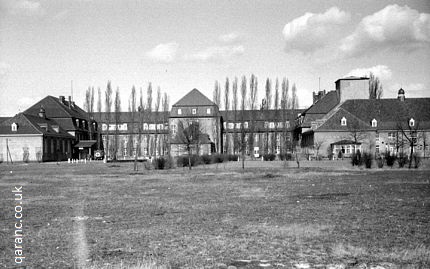
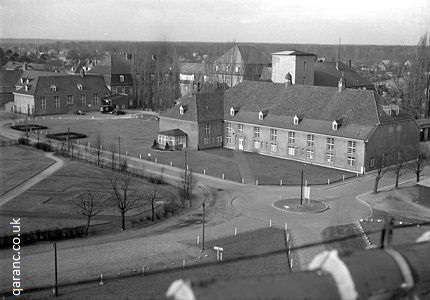
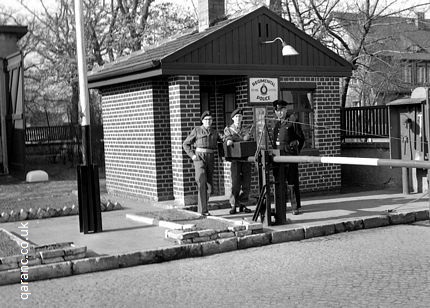
Regimental Police Security check point.
See more of Peter's photos from this era on the BMH Iserlohn, BMH Munster, Brandenburg Gate Berlin Germany Post World War Two, Kurfurstendamm Avenue Berlin Germany after Second World War Photo, Reichstag Building, Royal Army Medical College Millbank and the Russian War Memorial Gardens pages.
The photo of BMH Berlin below was how it looked in 1969.
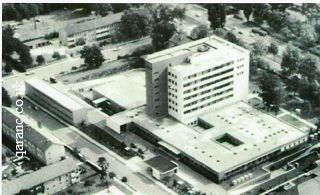
The new BMH Berlin building was opened in May 1967 (cited in the book Sub Cruce Candida: A Celebration of One Hundred Years of Army Nursing
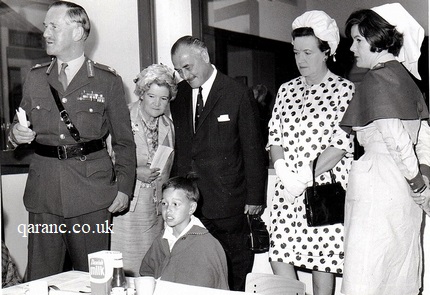
Lieutenant Pat Finn, on the far right, is pictured at the opening day BMH Berlin 1967.
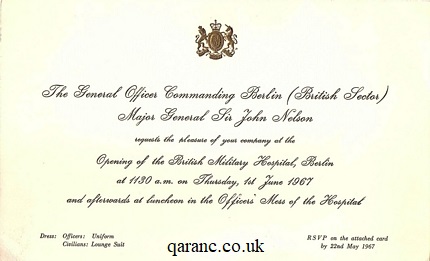
Her invite reads:
The General Officer Commanding Berlin (British Sector) Major General Sir John Nelson requests the pleasure of your company at the British Military Hospital, Berlin at 1130am on Thursday, 1st June 1967 and afterwards at luncheon in the Officers' Mess of the hospital.
Dress: Officers: Uniform
Civilians: Lounge Suit
RSVP on the attached card by 22nd May 1967
Pat enjoyed sightseeing in East Germany during her posting and is pictured here in her QARANC No. 2 uniform.
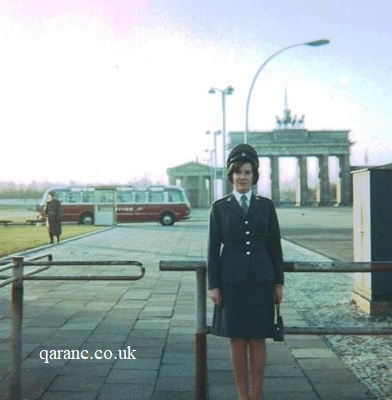
Treptow Cemetery East Berlin 1967 with USSR soldiers.
Read Pat's memories further below.
Follow us on Facebook, Instagram and Twitter.

My PTSD assistance dog, Lynne, and I have written a book about how she helps me with my military Post Traumatic Stress Disorder, anxiety, and depression. I talk about my time in the QAs and the coping strategies I now use to be in my best health.
Along the way, I have had help from various military charities, such as Help for Heroes and The Not Forgotten Association and royalties from this book will go to them and other charities like Bravehound, who paired me with my four-legged best friend.
I talk openly about the death of my son by suicide and the help I got from psychotherapy and counselling and grief charities like The Compassionate Friends.
The author, Damien Lewis, said of Lynne:
"A powerful account of what one dog means to one man on his road to recovery. Both heart-warming and life-affirming. Bravo Chris and Lynne. Bravo Bravehound."
Download.
Buy the Paperback.

This beautiful QARANC Poppy Pin Badge is available from the Royal British Legion Poppy Shop.
For those searching military records, for information on a former nurse of the QAIMNS, QARANC, Royal Red Cross, VAD and other nursing organisations or other military Corps and Regiments, please try Genes Reunited where you can search for ancestors from military records, census, birth, marriages and death certificates as well as over 673 million family trees. At GenesReunited it is free to build your family tree online and is one of the quickest and easiest ways to discover your family history and accessing army service records.
More Information.
Another genealogy website which gives you access to military records and allows you to build a family tree is Find My Past which has a free trial.
In the photo below is Lieutenant Aileen Philpott, pictured at work in BMH Berlin.
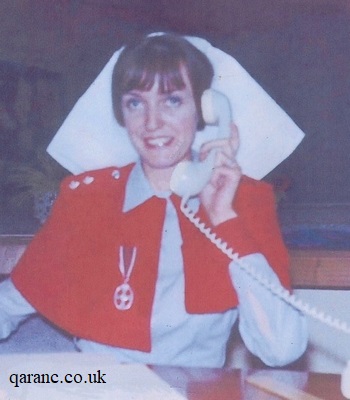
Her husband, Dennis Bristow, was a Path Lab Tech at Tidworth Military Hospital 1966-69. During their courting, Aileen was a QARANC nursing sister, working at the time on the Officer's Ward. Once the Commanding.Officer learnt they were a couple, she was promptly posted to BMH Iserlohn and later to BMH Berlin, where she worked on the Medical Ward.
Dennis told us: She said that there was a large metal door that was always locked. This led into a completely isolated and furnished suite for the exclusive use of Rudolf Hess, should he require it. Hess was at the time held in nearby Spandau Prison, and yes, latterly, it was used for him.
Whilst there, she went on an escorted trip through Checkpoint Charlie on a couple of occasions. One to transport an ill child either to or from the Eastern Sector for emergency treatment. On another occasion, she went on a shopping trip to East Berlin. She said it was horrendous. The desolation and poorly maintained areas she was driven through were very depressing. She bought a picnic set in a blue and white suitcase, filled with cups, saucers and two silver thermos flasks, all handmade, which we used for years after leaving the army. She paid the equivalent of £2 for it!! Cash was so rare in the East, even at that time.
She resigned her commission in 1969, joined me back in Tidworth, we married and she took up as a civilian sister back on the same wards where she used to work in the hospital. I lost her in May 2020 to dementia and Covid after 53 years of fantastic marriage, giving us two children and one grandson - so far!
She said that working at BMH Berlin was some of the happiest working days of her time as a QARANC officer.
Address of BMH Berlin
The old BMH Berlin was sited in the Spandau borough of Berlin and the new built BMH Berlin was in Charlottenburg area. The old hospital is now a police barracks located toward the east end of Radeland Strasse. The building is still there and can be viewed on Google maps and streetview. The new hospital continues to be a community hospital. You can view the area of BMH Berlin on Google Maps by typing Berlin into the search box, then Dickensweg. It is the block surrounded by Dickensweg to the North, Ragniter Allee to the East, Heer Strasse to the South, and Passenheimer Strasse to the West. There are lots of streets around there named after British authors and poets. The military post code for Berlin was BFPO 45.
The best directions to get there recently is to not go by it being in the Charlottenburg district, as maps suggest, but by the closest s bahn Olympia steady.
It is said of the old BMH Berlin that what was above ground was also below ground, ie. a bunker. More about this underground hospital is written below with some photos of the sub-basement emergency hospital.
Ambulance Train Squadron RAMC (V) were based here.
Sadly none of the QARANC.co.uk team had a German posting and would love to expand this page with more details about this former army hospital and include a photograph. If you are a former or serving member of the Queen Alexandra's Royal Army Nursing Corps we would love your help.
If you would like to contribute any info, photographs or share your memories of BMH Berlin then please contact me.

Former Royal Air Force Regiment Gunner Jason Harper witnesses a foreign jet fly over his Aberdeenshire home. It is spilling a strange yellow smoke. Minutes later, his wife, Pippa, telephones him, shouting that she needs him. They then get cut off. He sets straight out, unprepared for the nightmare that unfolds during his journey. Everyone seems to want to kill him.
Along the way, he pairs up with fellow survivor Imogen. But she enjoys killing the living dead far too much. Will she kill Jason in her blood thirst? Or will she hinder his journey through this zombie filled dystopian landscape to find his pregnant wife?
The Fence is the first in this series of post-apocalyptic military survival thrillers from the torturous mind of former British army nurse, now horror and science fiction novel writer, C.G. Buswell.
Download Now.
Buy the Paperback.
If you would like to contribute to this page, suggest changes or inclusions to this website or would like to send me a photograph then please e-mail me.
Memories of BMH Berlin
Millions Like Us: Women's Lives in War and Peace 1939-1949
***********************************************
Memories of a QA officer 1966-68
I went up to Berlin from BMH Hannover spring 1967 on the Military Train. I was wearing my No. 2s, and subject to various checks at the East German and Russian borders. The train was delayed, and we were late arriving at Charlottenburg station. Everyone was met by official transport, but not me! I spoke a little German; enough to get me to the QA mess by taxi in Spandau District, an old house with a long walk up the path to the front door in the dark (Apparently the colonel forgot to order the transport). A QA in pyjamas answered my very late doorbell ring, but I was warmly welcomed in by her and another QA officer. Neither had an idea I was arriving, and they were cross on my behalf. I do not recall the next few days, but I have a few memories of the old BMH (handed over in 1945 in Spandau to the British in West Berlin).
It was a farmhouse with and outbuildings in two parts separated by a large cobble yard and on those cold nights visiting the wards meant I had to cross this dimly lit yard. The RAMC orderlies scattered sugar on the cobbles and stairs, so the crunching sound of my footsteps warned them an officer was on her way. No QA Other Ranks served in Berlin. There were 6 nurse ward sisters, which included 4 midwives, 2 trained general nurses, a theatre sister who was a major due for retirement, and the forgetful colonel who also was due to retire. There were also 2 civilian trained nurses, one English (hoping to visit the East and her fiancee's parents to introduce herself) and the other German (I still cross my 7s to clarify the dose, date etc). The only other female officer in Berlin was a WRAC captain or major who lived in another mess elsewhere.
BMH Berlin staff were in the middle of a busy time. The new BMH had been completed but hadn't been fitted out. But as soon as bedding, beds and surgical equipment was delivered it was stolen, so the RAMC staff were often on duty overnight to protect the hospital from thieves and often half asleep on ward duty the next day.
Eventually the day came for the opening day and we, the QAs found we weren't invited to the grand opening by the general and his wife!! We had toiled for several weeks in our off duty to get the wards ready for the patients to be moved across on one day smoothly. That omission was corrected very soon after a complaint by one of the RAMC Doctors!
I had the Families Ward for the female adults and children. I knew a little about children's illnesses. I was shown, very proudly, their area in the ward. Unfortunately, it was only supplied with cots and low toilets. Not much use to a 15-year-old lad who didn't sleep in cots and that the toilets would need careful aim! And the electric sockets were all at toddler height, making them available through the cot rails!! Much had to be corrected.
Soon afterwards, it was realised there was no secure room for Hess should it be needed whilst the British were responsible for him, for about three months each year. The other quarters were the responsibility of the Americans, the French, or the Russians. This was their way of guaranteeing some Russian presence in West Berlin. There were other sites too where they had the right to be present, a war memorial, for example, where there were always 2 sentries on duty, it was built before the division was agreed.) This was useful when their plane crashed into the Havel Lake!
However, the female ward had one single room, so it was adapted pretty promptly, but not used by Hess in my time, but I did put patients in it when necessary.
The 3 or 4 permanent midwives covered the day and night shifts. One broke her arm, and I, having done Part 1 midwifery, was called one night to be supervised by the injured midwife to deliver a baby whilst her sergeant husband took photographs!! He sent me one later of me, and I look washed out. I have to hope he didn't put the rest on the mess notice board!!
Our new mess was mixed, but males slept on one side, and the QAs on the other. Even husband and wives couldn't sleep together!! We had common rooms, and a games area with a billiard /snooker table. Again, I was lucky as I played snooker with my father growing up. I became mess officer but of course rationing was still on and we might only get from NAAFI supplies 5 chops for 9 living in officers. I was Deputy Vice for Dining in nights, causing much teasing etc! The one living in male, a Major Terry Reeves (I think) told us of the state the old farmhouse was when as sort of Quarter Master officer he took the building officially handed back to West Berlin presumably back in 1945 or a bit later. He recalled how ignorant the occupying soldiers had been about the toilets used for another purpose (the mind boggles) and taps left running, and it was in a dreadful state, stripped of much to take back home to Russia.
The new BMH hospital had a cellar fitted out for casualties. An operating theatre and cramped beds for emergencies. Rocking Horse exercises were called at irrational times, day or night, and it kept people alert. I nearly always chose to return patients to their family regiments. Really serious cases for significant operations etc were sent to the UK soon after admission, anyway.
The new BMH was close to the Olympic stadium and more central to the city centre. Officers only were welcome on one afternoon a week to the Olympic pool, so one of the midwives and I went along for a dip, but we were challenged as we were female. The captain midwife with me soon put the guard right. Social life for females was terrific. We were often asked to parties, dinners, trips to the nightclubs to escort visitors to the same to avoid being robbed by "hostesses." If we needed more ladies, I would ask the BFES teachers to make up a party. Many have stayed my friends and are in touch.
If the colonel was invited somewhere officially, she would tell me to change my duty shift to accompany her!
I recall seeing curtains still pinned to the early boarded up blocks or flats that were part of the wall, (Bernauer strasse) and wooden steps at the west side of the wall with families with binoculars looking over trying to see their families trapped in the East and even holding up a new grandchild. All very sad.
One disconcerting thing was the way if I was waiting at NAAFI Square to catch the local bus back to the mess a car would draw up, a male voice would enquire if I needed a lift back to Herr Strasse and the BMH. They were of course the Military Police who probably had my picture on file, (or a wife had been a patient). But it made me think. How much did they know about me! I certainly lost count how many times I signed the Official Secrets Act.
We were encouraged to ask the Army for a car and driver to go to East Berlin, via Checkpoint Charlie, to help keep that official traffic route open. I wore my No. 2s of course, but to East shopkeepers I looked Russian!! I used my West German Deutschmarks at the Zoo bank, to exchange them for East DMs at a very good rate. It meant at Christmas I had a colourful decorated ward due to buying carnival bunting in the East; SAAFA Sisters often visited the porcelain outlets and bought beautiful pieces.
Sports were encouraged in the Army of course and every winter I was sent on Exercise Snow Queen (!!) sometimes to race against the WRAC at the end of the second week. I usually went twice each winter until posted to Hong Kong and reaching the rank of captain.
It was a good life and I am very proud to have been a QA. I met my future husband; an RAF officer and we had a good life together for 50 plus years. He returned to flying duties in the UK. My son was born in West Berlin, but later getting his passport replaced for a school trip to Russia proved to be awkward. We were very excited when the wall came down in 1989 and visited the year after and saw the magnificent, restored Reichstag. We visited RAF Gatow by then becoming a housing estate, and the BMH hospital being adapted for the Germans, but the guard let us in to wander around when he learned of my early days there.
Another time we took a sentimental journey on the Military train and our old passes were much admired and photographed by enthusiasts.
I kept nursing whenever I could but became an active member of the RBL and planned their Parades! I place a QA wreath every year on the local war memorial.
Patricia Roberts (nee Finn)
Read more of Patricia's memories on the Tippet page.
***********************************************
Carol Sutton was amongst the first other ranks to be posted to BMH Berlin in 1972 along with 5 other QAs. It was a trial for 9 months from BMH Hannover and her name at the time was Carol Chamberlain. The group were present when Princess Margaret visited, and they were invited to have coffee with her.
Carol shared a newspaper cutting which read:
The arrival of QARANC other ranks to the hospital. This is the first time in the varied history of BMH Berlin that QARANC other ranks have been on the strength of the unit, although only 'on loan' from BMH Hannover for periods of 9 months. So we welcome Cpl McGregor and Privates Chamberlain, Ivory, Lunn, Mitchell and Parkinson to Berlin and to the unit. We wish them a very enjoyable stay. They have made their presence felt already, particularly in the Needles' Inn, where it is noticeable that some of the male members of the unit no longer spend their evenings propping up the bar, but now spend them propping up their egos.
***********************************************
David Belton has been kind enough to share his memories and photographs of the first BMH Berlin from when he served in the Royal Army Medical Corps as a National Serviceman between December 1953 and November 1955.

I arrived in Berlin at six o'clock in the morning at the beginning of March 1954 feeling somewhat washed out having travelled up from Hanover on the ubiquitous over-night troop train. Between Helmstedt and Berlin we passed through the Russian Zone of Germany. To conform to the strict requirements of the Soviets the train left Hanover at midnight, all blinds were drawn so that we could not see from the train. The engines were changed at Helmstedt and the sound of unseen boots tramping up and down the platform outside was a little nerve wracking. Little wonder I was not feeling or looking my best on arrival at the Hospital.
I was destined to be a clerk at the Hospital, having completed a month long clerks' course at Queen Elizabeth Barracks, Crookham after basic training. So, after a chance to wash, shave and have some breakfast, I was taken to meet the Chief Clerk, Sergeant Wrightson. He looked me up and down and did not seem too impressed with what he saw. I was set to work in the Hospital Office next door along the corridor. The only other person working in the Hospital Office was a young German woman, introduced as Hannelore. She maintained Officers' records and typed correspondence for the Commanding Officer.
I quickly learned the routine which entailed typing stencils for Part I and Part II Orders, printing and distributing the copies made there from. I maintained the Hospital Register that recorded all Hospital admissions and discharges and had to take pay to patients on the wards when it arrived from their respective units. All treatment/operations were recorded manually by the doctors and surgeons. These had to be typed onto official forms with copies despatched to various records offices and others for inclusion in each soldier's personal records. This was not always an easy task as almost by tradition, doctors' handwriting is seldom entirely legible.
In addition to these routine duties, I was a general dogsbody at the beck and call of the Chief Clerk, the Company Officer Captain Hill, the meek and mild Company Sergeant Major WOII Castree and occasionally the Commanding Officer Colonel Hennessey. The CSM was nothing like those I had encountered in basic training. A State Registered Nurse, he once told me that he would have been happier working on the wards rather than having an administrative-cum-disciplinary post. His right hand man was Sergeant Cyril Woods with whom he shared his small office. As Orderly Sergeant, Cyril kept an eye on the German cleaners who were engaged to keep the premises spick and span. He also dealt with applications for late passes and leave passes although these were prepared by the Company Office, the Hospital's equivalent to a Personnel Department responsible for the records of all RAMC Other Ranks.
Sergeant also handed out the bus tickets we would use for free travel on Berlin buses and trams, the U Bahn and Stadt Bahn. On payday (Thursday) every soldier was handed two tickets that entitled him to purchase a hundred and forty cigarettes from the NAAFI at a shilling for twenty. Cigarettes were currency: the German barber who kept the men's haircuts within reasonable bounds - that is to say far from short, would buy the cigarettes at a Deutsch Mark for twenty. The rate of exchange was one shilling and eight pence to the mark, so the sale represented a 66.6% profit. That profit was increased still further if the Deutsch marks were exchanged for Ost Marks for use in Soviet East Berlin as the rate of exchange was five Ost Marks for one Deutsch Mark. It was permissible to travel into the Russian Sector except on special days such as May Day We could purchase food and drink, theatre and opera tickets but we were no supposed to buy goods and souvenirs as that would support the East German economy.
We were paid in British Armed Forces Vouchers (known colloquially as Baffs) as Sterling notes were subject to UK currency controls at that time. These could be spent in the NAFFI, TocH Clubs and canteens and the Red Shield Clun run by the Salvation Army. Part of our pay could be taken as Deutsch Marks for use in German shops, bars etc. The Company Officer was responsible for the pay parade on a Thursday morning and was assisted by Herr Bruno Greiser the German pay clerk who maintained the company imprest account. A retired banker who had worked in the UK prior to the outbreak of war and who had been interned on the Isle of Man for the duration, Herr Greiser worked in the Company Office. There were two other German clerks on the Administration staff. Frau Grunau and Herr Ben Schneider ran a very efficient Records Office. Every piece of post that came in and went out and all documents produced were carefully logged and filed away. Nothing was ever lost and all files were maintained in pristine condition.
The other clerks were Corporal James Barrow, Privates Brian Kinsey and Bernard Fairclough at the time of my arrival. They worked in the Company Office and as National Servicemen; they each completed their two year's service during my time at the Hospital. On the departure of Jim Barrow, I was promoted to Corporal and was put in charge of the Company Office. As people moved on, so they were replaced by men from subsequent intakes posted after training from the UK.
Beyond this office, the corridors led to the Maternity Ward and the NAFFI Canteen as well as the Dining room and kitchen that catered for other ranks. The Officers' and Sergeants' Messes were at the end of the building.
The Deputy Direct of Medical Services, Major Barry RAMC supported by his own clerk had his office beyond that of the matron. While in the other direction was the Post Room, manned by a Lance Corporal and the Transport Office. A number of civilian drivers were employed to run people around in VW Beetles. Senior NCOs and Officers had access to transport that was otherwise used by junior ranks on business. This included collecting post and pay from brigade HQ at the Olympic Stadium and stationery from the Ordnance Depot. The Colonel had his own driver, Pte Bob Pope RASC, who drove the CO in an Opal Capitan saloon. Ambulances were controlled by the Royal Army Service Corps from its depot a short distance away from the BHM itself. The only member of the RAMC who drove a vehicle was the Sergeant who with a private soldier constituted the Hygiene Department.
Finally, there was the Reception area with a Sergeant in charge assisted by a private soldier with a doctor on hand to assess each new arrival.
The first floor accommodation in this block was occupied as barrack rooms for the soldiers with bathrooms and the barber shop. There was a chapel where Captain Henson held Sunday services that were attended by both staff and patients. One of the Ward Sisters, QARANC Captain would march her 'walking' patients to morning service, something that was always a source of amusement. There was also accommodation for the German civilian nurses employed at the hospital.
All this was housed in A Block that fronted Radeland Strasse.
The second large building, B Block situated a short distance away across what might loosely be referred as a parade ground and sports field housed the three main wards. In the semi basement the Quarter Master had his domain. All bedding, hospital blue uniforms and other stores passed through here as well as laundry for both hospital and staff. On the first floor there was the surgical ward, operating theatre and hospital kitchen where patients' meals were prepared. On the second floor there was the medical ward, 'skin' ward, pharmacy, TocH canteen, eye department, dental department: the domain of the Royal Dental Corps and the office of the Gynaecologist with his clerk; a very eccentric German lady whose typing speed was matched only by the speed at which she rode her bicycle to and from work.
The 'skin' ward was headed by Corporal Henry Bell. 'Dinger' was an SRN and the ward catered for patients who were registered as suffering with dermatitis. In actual fact most had acquired STD's but it was a court-martial offence to catch VD as it was classed as a self-inflicted wound so, the Hospital Register was economical with the truth to protect the stupid!
On the top floor there was the Officer's Ward and the Hospital cinema, where each Wednesday evening I showed a film for the benefit of patients and staff following a two week Projectionist Course in Minden under the auspices of the Army Kinema Corporation. The AKC operated the Jerboa Cinema at the NAFFI Club in Charlottenburg and I would have to go there to collect films to be shown in our own theatre.
Next to the cinema was the Detention Ward. Situated on the top floor with barred windows it comprised an area for the duty guard and small room that would be occupied by the prisoner. The location meant that escape via a window to the ground was impossible. On those occasions that inmates of Spandau Prison were brought here in addition to guards from the British Army there were guards from the USA, France and Russia. Each nation took it in turns to guard the prison for a month at a time. When, during a month that the UK forces were on duty, a prisoner, such as Rudolf Hess had to be hospitalised, he would be brought to the BMH together with a contingency of guards from each of the other nations. It seems no one trusted anyone in those days. In particular the Russians were adamant that each prisoner should serve his full term and in the case of Rudolf Hess, that meant life.
The Union Flag was flown each day on the top of this block and the soldier on duty had to make his way up to the attic, past a store of coffins to reach the flag pole via a ladder. The coffin store was eerie and as the flag had to be lowered at dusk, light in the attic was poor. Some of those appointed to flag duty found this somewhat intimidating!
At ground level and a little away from the main entrance there was the mortuary and pathology department. I cannot be sure whether it was the summer of 1954 or 1955 that two Grenadier Guardsmen had drowned while swimming in a static water tank. Whatever it was, the weather was very warm and they were brought to the mortuary for autopsy. There was no refrigeration unit so the bodies had to be kept cool with blocks of ice. There was growing concern over delay for repatriation to the UK but the problems were sorted and the deceased were duly moved down to the British Zone of Germany for onward flight to England.
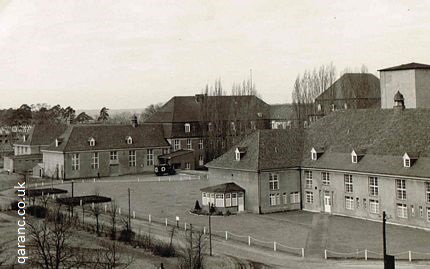
This is the rear of the Administration Block. The Maternity Ward is in the right foreground. Officers' Mess to the far left. The first floor of the tall central section is where the army personnel lived.
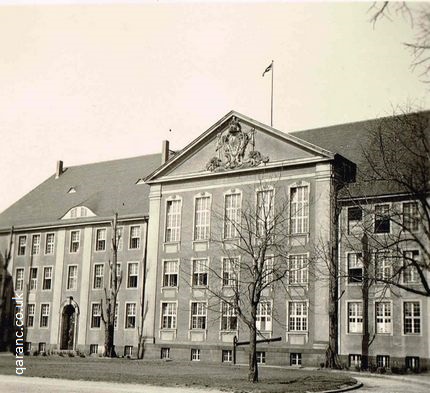
This is B Block as seen from the road. The semi-basement where the Quartermaster's Store was located can be seen with the Surgical Ward above. On the next floor is the Medical Ward. The tall central windows are those of the Hospital Cinema with the Officers' Ward to the left. On the right on this top floor is where the Detention Ward was located.
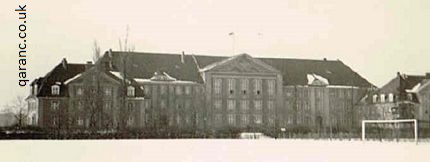
This is the rear view of the same block as seen from the sports field. The open windows in the centre are of the Officer's Ward.
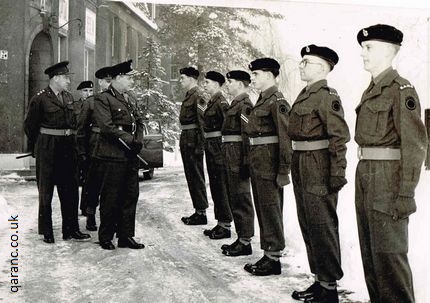
Early in 1955 the Brigade Commander, Berlin Independent Brigade came to inspect the Hospital. In this picture he can be seen with the small guard of honour. On the left is Colonel Hennessey. Partly obscured behind the Brigadier is Captain Hill, Company Officer. Behind him is Sgt Woods, the Orderly Sergeant. I am the corporal in the centre of the picture. The corporal third from centre is Ron Sutch of the Royal Signals Corps. He manned the Hospital switchboard during daytime. At night all incoming calls went straight through to the duty clerk who spent the night in the Hospital Office. Not long after this photo was taken, Captain Hill left for another posting and Major McGurgan took over as Company Officer. Sgt Wrightson, the Chief Clerk also moved on and Sgt Price joined us in his place.
I very much enjoyed my time at the Hospital and was sorry to leave when my tour of duty was up at the end of November 1955. I was assigned to the Territorial Army after demob and had to attend a two week training period with a Field Ambulance at Fort Tregantle in Cornwall during the summer of 1956. After that requirements for national Service underwent several changes and I finally handed in my uniform some months later. I consider myself very lucky to have had a good posting and many years later I was able to show my wife the place I had so many fond memories of. This is the photo I took now that the premises are occupied by the Police Academy.
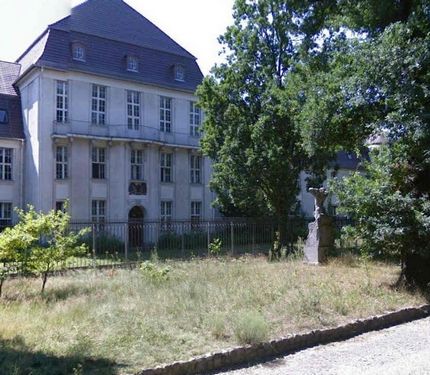
The windows to the left of the door are of the CO's Office, those on the right were of matron's office from which there was a view of the full frontal nude male statue which can be seen under the tree. The chapel was behind the windows on the first floor. The top windows were of the Education Centre which was not used during my time.
***********************************************
Reader Steven has provided these photos which show his father, the RMP (Regimental Military Police) leaning back in the jeep facing off the Russian backed East German army threatening to come into West Berlin in 1961. Steven was born in the old BMH Berlin in 1957. He was told that it was a former cavalry barracks and his father joked he was born in a stable!
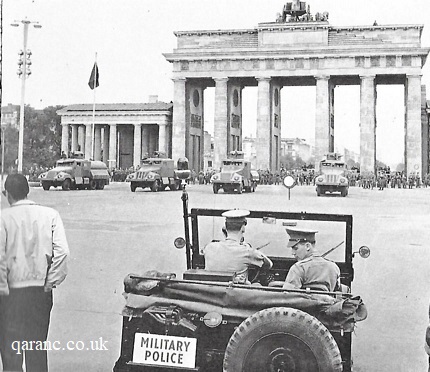
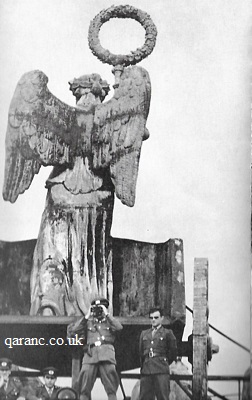
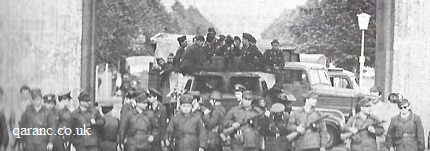
***********************************************
Re your piece on BMH Berlin. I served as an Infantry Medic with the Royal Hampshire Regiment from 1983 to 1985 and BMH Berlin was well known to me. Yes it did have a full hospital complex underneath the main building with external access provided by sloping ramps from the MT pool on the north side and if memory serves me right one on the south and east facing the main highway the Heestrasse.
The hospital was accessed internally through the sub basement via 4 foot thick blast doors with submarine type locking wheels and air filters for NBC/CBRN as its now known. All along the floor were luminous lines of different colour indicating where they led i.e mortuary purple building above was designed for in the event of a nuclear blast to collapse like a house of cards to give more overhead protection from the deadly radiation released. Richard Tyne
***********************************************
I worked at BMH Berlin as a civilian ("Labourer, General - 14 Indep PCLU") during 1969 and 1970. Administrative Officer in those days was Major D.P. Bullough, RAMC.
Indeed there was an emergency hospital under the main building, as Richard Tyne rightly says. This was there "just in case", and it was only used once or twice a year as part of the usual military exercises.
I remember these exercises as particularly pleasant because most BMH staff (including the sergeant in charge of us civilians) disappeared behind the thick bunker doors for hours, sealed off from the outer world - which meant leisure time for the rest of us, e.g. enjoying the extra cup of tea in the TocH, sunbathing on the roof of the main building, from where you had spectacular views over neighbouring Olympic Stadium or the skyline of Berlin. Those were the days ...
Dr. Christian H. Freitag
Qaranc.co.uk would like to thank Dr. Christian H. Freitag for the photograph of BMH Berlin at the top of this page and of the two hospital bunker photos. The signs inscriptions can still be seen on the corridor walls and read Wards 1 2, Theatres, Reception, Command Post and Ward 1 Command Post Male Staff.
***********************************************
I was in the Intelligence Corps in 1961 serving with a small army unit at RAF Gatow, Berlin. My wife and I lived in Charlottenburg and our daughter, Susan, was born at BMH Berlin on 29th September 1961. She owed her life to the close attention of the Queen Alexandra nurses, as the umbilical cord became wrapped round her neck in the course of labour. She was delivered by Caesarean section ( Kaiserschnitt!) by Major Shaw, obstetrician. Don Alexander
***********************************************
I also remember BMH Berlin, the sub-basement hospital-bunker was used by the stag guard whenever Hess was in for treatment, it was an arduous gig, with 18 hours on, 6 off, sleeping in the basement.
It was also used as a base for medivac exercises, the Doctors and Nurses making-up the wounds and injuries using surplus store clothing which could be cut, ripped and burnt. The troops - usually borrowed from the infantry - were given a broken arm, smashed-up face or asphyxia make-up, internal bleeding 'grey' etc...and sent to the 'battle field' in out-going ambulances, snuck into the scenario, treated with first-aid and sent back (often in the same ambulance! After it had gone round the corner to join the 'front end' of the exercise).
On the occasion I took part we worked out that if they gave me a pair of very large combat trousers I could fold my leg up inside, they then cut the leg at the knee, put a pink plasticine 'crater' over the knee, ran a catheter tube from the knee to a blood-bag at my waist/belly, stuck some bits of smashed bone and bacon in the plasticine, smeared it with a maroon gelly, blocked the catheter with a bit of goo and liberally coated the area in red ink before sending me out in the ambulance.
When we got to Ruleben Fighting City, I was carried into the back of one of the buildings (I couldn't walk very well and they wanted the wound to stay intact and laid out on the floor, a thunder flash was set off and I was told to keep screaming until I got in the ambulance, and start screaming again when we got back to BHM!
Medics ran in, saw the blood spurting from my missing leg and momentarily thought I was a 'No Duff'! dealt with me - Tourniquet and then ignored me while they dealt with the more complicated/serious stuff. By the time they got me and another amputee (arm) on stretchers the last ambulance (we had Unimogs in BB) had left so they chucked us both in the back of an open-topped Lanny.
Just after we turned off the Heerstrasse and were curling round the side of the Olympia Stadion my weight shifted or my arm fell across my stomach or something, anyway the catheter started pumping the dregs of the blood-bag which spread out the back in the slipstream and a young German woman following us in a silver VW crashed into the line of parked cars beside the stadium, whether it was due to blood on the windscreen or shock at what she 'thought' she'd seen we never knew as the medics had worked out what was happening and high-tailed it round to the hospital and shot down the ramp!
I also had 4 wisdom teeth extracted in one go under 'general' at BMH Berlin and was in and out in less than 24 hours. Hugh Walter, late 1 Glosters, Berlin Brigade 1986 - 1988.
***********************************************
I worked as a civilian at the BMH in Berlin in about 1971 working under Sgt Major Ray Martello whose senior officer was Major Saxton. It was a twelve storey hospital - six up and six down - which hopefully would virtually never be used. I understood that the holdout period for West Berlin was set at about 48hours whilst the expected time for the Russians to reach the Channel Ports was 36hours.
I was employed to work with German Staff of the Personnel Civilian Labour unit - I worked as a "Hygiene Control Officer" with one Rembert "Hans" Pallaske - a German Stalingrad veteran (Panzer driver). The secretaries in my group were Frau Mommert - an English woman married to a German- and Frau Ilse Winkler. I worked there for a year, during which we caught one rat!
We had a Land Rover and driver every day and went everywhere in the British sector including the observation post in the Reichstag, Spandau Prison which did a very good breakfast, Montgomery Base where we nearly set fire to the Ammo dump by mistake when killing a wasp nest . Hans filled the hole up with kerosene and was about to throw in a match when the MPs stopped us and took us inside to see what the "hill" actually was. We also went to Villa Lemm and all over the Olympic Stadium HQ - I kept a record of the number of ducks in the small outside swimming pool near the diving pool - I was bored. We drove there every day for six weeks to count them - no-one asked why I kept a duck ledger!
My co-workers brother drove a Beer truck in Berlin "Berliner Kindl". he had been on Hitler's Chancellery Guard and met Hitler every day for some eighteen months. Sometimes I went across the Wall at Friedrichstrasse to see Berliner Ensemble Productions. I used to do little dances in the back of the Land Rover to see if I could make the Russian contingent in their Soviet Microbus smile. They never changed their expression for a moment, even at Checkpoint Charlie when my English girlfriend wasn't too polite to the border guard inspecting the car - She was terrible at borders! Phil Clarke
***********************************************
Rudolf Hess
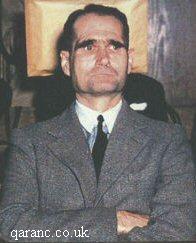 The most infamous patient at BMH Berlin was the deputy leader to Adolf Hitler and the Nazi party Walter Richard Rudolf Hess who was captured during a flight to Scotland in May 1941 at the height of World War Two. He was tried at the Nuremberg Trials and sentenced to life imprisonment and was imprisoned at nearby Spandau Prison. During periods of ill health he was admitted to BMH Berlin where an entire floor would be shut off and secured for his treatment.
The most infamous patient at BMH Berlin was the deputy leader to Adolf Hitler and the Nazi party Walter Richard Rudolf Hess who was captured during a flight to Scotland in May 1941 at the height of World War Two. He was tried at the Nuremberg Trials and sentenced to life imprisonment and was imprisoned at nearby Spandau Prison. During periods of ill health he was admitted to BMH Berlin where an entire floor would be shut off and secured for his treatment.
In her book Tales of a Lady in Grey with a Touch of Scarlet
Double Standards: The Rudolf Hess Cover-Up
He was also kept as a prisoner under escort in Drymen Military Hospital Buchanan Castle Scotland for several days after he landed in Britain.
Rudolf Hess died on the 17 August 1987 by suicide at Spandau Prison. He asphyxiated himself with a cord attached to a window latch in a summer house within the prison. He was aged 93 years. He was called prisoner number seven of the Nuremberg Trials.
Another British Military Hospital connection with Rudolph Hess was when his aircraft crashed in Britain which led to his capture. This was near Eaglesham in Renfrewshire Scotland. There was a temporarily emergency hospital for the services here and the servicemen patients went to the downed aeroplane and collected souvenirs. There is a photograph in the collection of the Royal College of Physicians and Surgeons in Glasgow showing some British army patients placing the swastika from the plane wreckage onto their barrack block wall. This hospital was formerly the Mearnskirk tuberculosis convalescence hospital and after the war and the last Navy patients left in 1946 the hospital returned to its original function though as the incidence of tuberculosis reduced the building and staff turned to other specialities such as the care of patients with polio and then elderly care.
Photographs of BMH Berlin
The photograph below is how BMH Berlin looks now. It is a the cardiac treatment centre for Berlin, The Paulinenkrankenhaus. See www.paulinenkrankenhaus.de
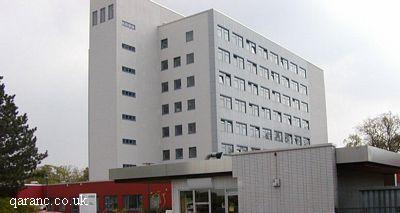
View more Photographs of Berlin at
www.pbase.com/sasaferrato/berlin&page=all
Do you know the address for BMH Berlin or have directions to get to BMH Berlin? If so please contact QARANC.co.uk so that we can add this info to the page. Thank you!
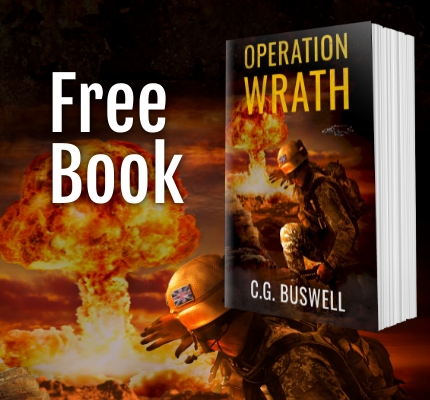
Free Book.
The death of the Brotherhood will be avenged.
RAF gunner Jason Harper and a team of Special Air Service operators are enraged after the death of their brothers by a terrorist drone strike. They fly into south-eastern Yemen on a Black-op mission to gather intelligence and avenge the death of their comrades.
Can they infiltrate the Al-Queda insurgents' camp, stay undetected, and call down their own drone missile strike and get home safely?
Will they all survive to fight another day?
Operation Wrath is a free, fast-paced adventure prequel to the non-stop action The Fence series by military veteran author C.G. Buswell.
Download for free on any device and read today.
This website is not affiliated or endorsed by The Queen Alexandra's Royal Army Nursing Corps (QARANC) or the Ministry of Defence.
» Contact
» Advertise
» QARANC Poppy Pin
» Poppy Lottery
» The Grey Lady Ghost of the Cambridge Military Hospital Novel - a Book by CG Buswell
» The Drummer Boy Novel
» Regimental Cap Badges Paintings
Read our posts on:
Offers
» Army Discounts
» Claim Uniform Washing Tax Rebate For Laundry
» Help For Heroes Discount Code
» Commemorative Cover BFPS 70th anniversary QARANC Association

Present Day
» Become An Army Nurse
» Junior Ranks
» Officer Ranks
» Abbreviations
» Nicknames
» Service Numbers
Ministry of Defence Hospital Units
» MDHU Derriford
» MDHU Frimley Park
» MDHU Northallerton
» MDHU Peterborough
» MDHU Portsmouth
» RCDM Birmingham
» Army Reserve QARANC
Photos
» Florence Nightingale Plaque
» Photographs
Uniform
» Why QA's Wear Grey
» Beret
» Army Medical Services Tartan
» First Time Nurses Wore Trousers AV Anti Vermin Battledress
» TRF Tactical Recognition Flash Badge
» Greatcoat TFNS
» Lapel Pin Badge
» Army School of Psychiatric Nursing Silver Badge
» Cap Badge
» Corps Belt
» ID Bracelet
» Silver War Badge WWI
» Officer's Cloak
» QAIMNSR Tippet
» QAIMNS and Reserve Uniform World War One
» Officer Medal
» Hospital Blues Uniform WW1
Events
» Armed Forces Day
» The Nurses General Dame Maud McCarthy Exhibition Oxford House London
» Edinburgh Fringe Stage Play I'll Tell You This for Nothing - My Mother the War Hero
» Match For Heroes
» Recreated WWI Ward
» Reunions
» Corps Day
» Freedom of Rushmoor
» Re-enactment Groups
» Military Events
» Remembrance
» AMS Carol Service
» QARANC Association Pilgrimage to Singapore and Malaysia 2009
» Doctors and Nurses at War
» War and Medicine Exhibition
» International Conference on Disaster and Military Medicine DiMiMED
» QA Uniform Exhibition Nothe Fort Weymouth
Famous QA's
» Dame Margot Turner
» Dame Maud McCarthy
» Lt Col Maureen Gara
» Military Medal Awards To QAs
» Moment of Truth TV Documentary
» Sean Beech
» Staff Nurse Ella Kate Cooke
Nursing
Nursing Jobs Vacancies UK
International Nurses Day
International Midwife Day
Info
» Search
» Site Map
» Contact
» Other Websites
» Walter Mitty Military Imposters
» The Abandoned Soldier
We are seeking help with some answers to questions sent by readers. These can be found on the Army Nursing page.
» Find QA's
» Jokes
» Merchandise
» Mugs
» Personalised Poster
» Poppy Badges
» Stamp
» Teddy Bears
» Pin Badges
» Wall Plaques
» Fridge Magnet

